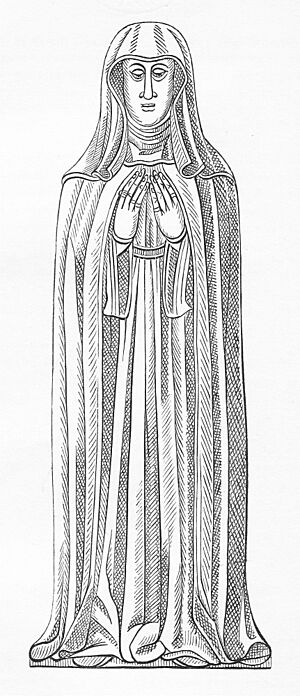Agnes Jordan facts for kids

Agnes Jordan (born before 1520 – died January 29, 1546) was the very last leader, known as an Abbess, of Syon Monastery before a major change in England called the Reformation. She was forced to sign a document on November 25, 1539. This document suddenly ended the monastery's life and gave all its property and money to Henry VIII, the King of England. Agnes Jordan was also the sister of Isabel Jordan, who was a prioress and later an abbess at Wilton Abbey.
Who Was Agnes Jordan?
We don't know the exact year Agnes Jordan was born. However, we do know she had a sister, Isabel Jordayne, who also became a nun and an abbess. Before 1520, not much is known about Agnes Jordan's life. In 1520, she was chosen to be the abbess of Syon Monastery. She took over after Constance Browne, who had died that same year.
In 1530, Abbess Jordan asked for a special book called The Mirror of Our Lady to be printed. This book was a guide for the nuns. From November 1536 to October 1537, Agnes Jordan had a special guest at the monastery. She hosted and also kept Lady Margaret Douglas confined there. Lady Margaret was staying at Syon because she had married Lord Thomas Howard without the King's permission.
The End of Syon Monastery
By the time Agnes Jordan became abbess, big changes were already happening in England. These changes would lead to the Dissolution of the Monasteries, which meant many monasteries would be closed down. In 1534, Abbess Jordan and the nuns at Syon agreed to the Act of Supremacy. This act declared King Henry VIII as the head of the Church in England, not the Pope.
The next year, in 1535, two groups visited Syon Abbey to check on its wealth and how the nuns were living. At this time, Syon was the richest nunnery in all of England. When the process of closing monasteries began in 1536, Syon was not immediately affected because it was one of the larger abbeys. However, it did feel some impact. Abbess Jordan welcomed the prioress and two nuns from a smaller Benedictine monastery in Somerset that had been closed.
Finally, Syon Abbey was officially closed and taken over by King Henry VIII on November 25, 1539. Abbess Jordan was forced to sign a document that gave all the monastery's property to the King. King Henry VIII then had the building destroyed soon after.
Later Life and Legacy
Agnes Jordan wrote her will on October 28, 1545. She passed away on January 29, 1546. She was buried on February 9, 1546, in Denham, Buckinghamshire. Her special metal plate, called a Funerary Brass, is now kept in Denham Church. Her original tombstone has been lost, likely sometime between 1840 and 1904. The tombstone used to say:
Of your charitie pray for the soul of Dame Agnes Jordan, sometime Abbess of the monastery of Sion, which departed this life the 29th day of January in the year of our Lord God 1545. On whose soule Jesus have mercy. Amen!
Images for kids


